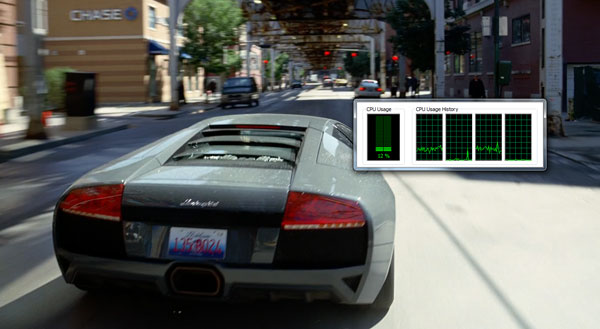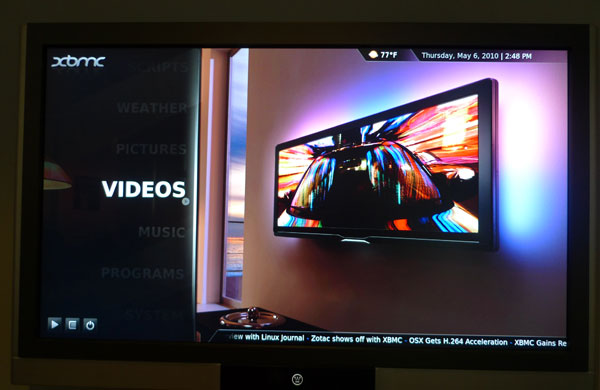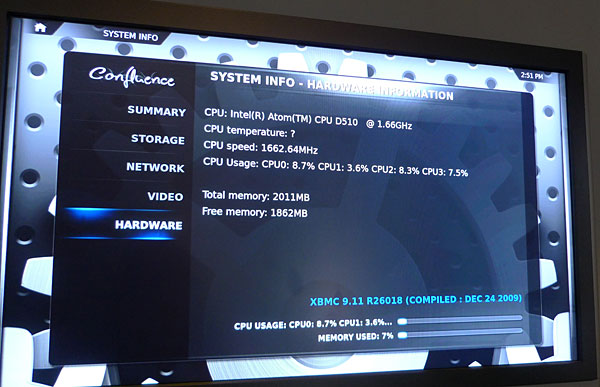Zotac ZBOX HD-ID11 Review: Next Gen ION is Better & Worse than ION1
by Anand Lal Shimpi on May 6, 2010 3:51 PM EST- Posted in
- GPUs
- Next Generation ION
- HD-ID11
- ZOTAC
- NVIDIA
H.264 Decode Acceleration
Of course the whole reason you opt for a NG-ION (or ION) box is because you want to watch high definition content. The GT218 GPU at the heart of the NG-ION supports full hardware decode acceleration of all H.264 content. You can watch Blu-ray or even ripped BD content using something like Media Player Classic Home Cinema.

Watching The Dark Knight in MPC-HC results in ~12% CPU utilization on the Atom D510 with NG-ION
My personal favorite thing to do with these ION boxes is to load XBMC and use them to stream content to the TVs in my house. You get a great UI, the ability to play virtually everything over the network and there’s even an iPhone app to act as a WiFi remote control for the box (which is necessary given that Zotac doesn't include an IR port). You don’t get TrueHD/DTS-HD MA bitstreaming support, but you can send 8-channel LPCM audio over HDMI.


XBMC in action on the NG ION
The NG-ION works in both capacities. Playing individual H.264 content under Windows 7 was fully hardware accelerated. Getting the XBMC Live image to work took some effort. While it'll install to the system just fine, getting audio working requires an update to the alsa driver that comes on the image as well as a bit of tinkering. After installing the XBMC Live 9.11 CD image to the drive, I followed these instructions to update the Alsa Driver with one slight change to the process:
1. download the script and save it somewhere
2. cd <your-download-dir>
3. tar xvf AlsaUpgrade-1.0.22.1-2.tar
4. sudo ./AlsaUpgrade-1.0.22.1-2.sh -d
5. sudo ./AlsaUpgrade-1.0.22.1-2.sh -s
6. sudo ./AlsaUpgrade-1.0.22.1-2.sh -c
7. sudo ./AlsaUpgrade-1.0.22.1-2.sh -i
8. sudo shutdown -r 0
For me, step #5 was critical in getting the process to work. Afterwards, I had to download and apply the patch mentioned here to get the GT218 GPU recognized. Finally I followed the last two steps made in this post and got sound working in XBMC.

I suspect that once we start seeing NG-ION boxes ship in the coming weeks some kind souls will make XBMC Live discs specifically for those machines so you'll be able to avoid this process.











40 Comments
View All Comments
rnjeezy - Thursday, May 6, 2010 - link
and switch wifi to usbTekkamanraiden - Thursday, May 6, 2010 - link
While this looks pretty kick ass I'm looking forward to the Amd version. I'm curious how well the Neo processor with 3200 will do against the Aton with Ion2.Soulkeeper - Friday, May 7, 2010 - link
I too would like to see products from amd and/or via to compete here.I'm tired of "the intel show" 24/7
I wouldn't pay $100 for that ion thing
dealcorn - Friday, May 7, 2010 - link
As the Zotac NM10-B-E motherboard is shipping with HDMI and the Intel NM10 chipset, the Broadcom Crystal media solution is a viable build your own HTPC strategy that operates on fewer watts. I would have liked a side by side comparison.nick.cardwell - Friday, May 7, 2010 - link
Does this or any ION2 nettop use Optimus??? I am looking for a small D510 system to run headless and would be willing to buy an ION2 system strictly for the resale value if it uses Optimus to switch off that power hungry GPU. I am sill waiting on the Shuttle XS35 to show up as it is fanless.CZroe - Friday, May 7, 2010 - link
The comments in the article about manufacturers not wanting to reclaim PCIe lanes from WiFi and GbE don't sound so convincing. For example, they could easily integrate WiFi via internal USB or an Ethernet bridge.Heck, if nVidia wanted to make a real symbiotic chipset to go with this they could actually engineer a GbE/WiFi chip that uses multiple internal USB ports to achieve enough bandwidth. And by "enough" I mean "somewhat more than 100mbps but less than 1,000mbps." Users can't often maximize GbE because they need a GbE switch for full duplex and, assuming a max-speed file copy, a destination drive which can write as fast as the source can send. I doubt many users really need GbE over 10/100 Fast Ethernet/802.11n.
Also, what happened to all the rumors of an OC'd PCIe bus for ION2?
As for Zotac's design, I'd much prefer a larger, cooler, quieter design than this, especially if it is going in a home theater. If it would still be super-small, why not give it a proportionally huge HSF? The LEAST they could do is give it metallic housing and throw a heat pipe on it (even just one side).
rennya - Friday, May 7, 2010 - link
The latency guys, the latency.KaarlisK - Sunday, May 9, 2010 - link
Besides which, the NM10 chipset only has 1 USB2 controller, so no increase in bandwidth from ganging USB ports.modemide - Friday, May 7, 2010 - link
I enjoyed the article and this looks like a viable option for my next HTPC. However, I didn't see anything addressing the signal issues most people experienced with the initial version. Can you comment on that?Thanks.
Bateluer - Friday, May 7, 2010 - link
How come we don't see any of the ULV CPUs in form factors like this? I cannot imagine it'd be too difficult to stick in a Celeron SU2300, or a Pentium SU4100, or one of the ULV C2S chips. There's super netbooks that are thinner than these nettops that use these ULV chips. I can't imagine that designing a little beefier cooling system in the same Zotac chassis or into the Acer Revo chassis would be overly difficult. It may add a little to the price, but the trade off in performance might be worth it.